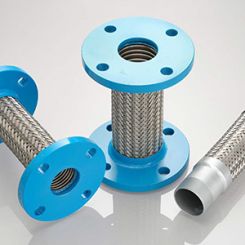Today, 90 percent of electricity generated in the United States comes from coal, nuclear or natural gas plants. Thermoelectric power plants boil water by burning a fossil fuel or through a nuclear reaction to create steam that spins turbines. Once steam passes through a turbine, it has to be cooled back into water before it can be reused to produce more electricity. Colder and cleaner water cools steam more effectively and allows more efficient electricity generation. Fifty years ago, inefficient once-through cooling systems were used to take water from rivers, lakes or oceans and circulate it through pipes to absorb heat from the steam in condensers. Once used, the water was discharged back to its local source. Today, there are still a few legacy plants in the U.S. that use this process, but almost all of them are in line for renovation as part of repowering efforts.
 Image 1. Water treatment applications are administered by injecting chemicals with metering pumps. (Images courtesy of Pulsafeeder)
Image 1. Water treatment applications are administered by injecting chemicals with metering pumps. (Images courtesy of Pulsafeeder)How Much Water Do Power Plants Need?
Coal-fired plants, relying on once-through cooling processes, need about 30,000 gallons of water for every megawatt of electricity produced. But plants with recirculating systems can make the same megawatt of electricity with just 5 percent as much water (about 1,200 gallons per megawatt). Nuclear plants, regardless of their cooling systems, require twice as much water as coal-fired plants. This unquenchable appetite for water, combined with the goal of reducing harmful carbon dioxide (CO₂) emissions, is driving momentum toward natural gas-powered plants that leverage dry-cooling processes. This is why almost all of the new power plants being built in China, India, Africa and other parts of the developing world are standardizing on natural gas combined-cycle (NGCC) techniques. Image 2. The appetite for water and the goal of reducing CO₂ emissions is driving momentum toward natural gas-powered plants that leverage dry-cooling processes.
Image 2. The appetite for water and the goal of reducing CO₂ emissions is driving momentum toward natural gas-powered plants that leverage dry-cooling processes.How Natural Gas Power Plants Operate
A NGCC power plant uses a gas combustion turbine to generate electricity, and it also uses waste heat to make steam, which then generates additional electricity in a steam turbine. Because the first stage (the gas combustion turbine) has no steam to condense, it does not require cooling. As a result, the combined process requires 25 percent as much water to generate the same electricity as a coal-fired plant. Image 3. Nuclear plants require twice as much water as coal-fired plants to produce electricity.
Image 3. Nuclear plants require twice as much water as coal-fired plants to produce electricity. 
